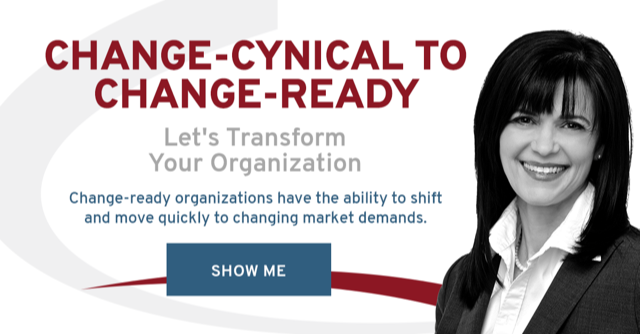How to Maintain Productivity During Organizational Change
Productivity has been on my mind lately for two reasons. One reason is that many leaders are asking about how to manage and maintain employee productivity in the virtual environment. The second reason is more personal. Over the past year, I have become more aware and sensitive to how my productivity has fluctuated. Some days have been highly productive. While other days, well, let’s say I chased a lot of squirrels.
That’s because our productivity is not static. It ebbs and flows depending on the situation, our environment, time management skills, and our physical and emotional state. Our mental energy and internal and external motivation can also influence our productivity.[1]
So, it’s not surprising that our productivity would be affected during change. Whether the change is planned or unplanned, productivity is affected. That’s why your organizational change capacity is so important.
Organizational change capacity is the ability to implement and sustain current changes while maintaining your current operation and setting up your organization and the employees to implement and sustain future changes.[2]
Every change your organization undertakes should make it and the people affected feel more capable for the next change that will be needed. Therefore, the question is not how do we maintain productivity during change?
The question change leaders need to ask is: How do we support and adjust productivity to ensure we build organizational change capacity so that the organization is healthier and stronger after adoption than before the change started? Because regardless of how well your change initiative is planned, productivity will be affected.
Defining Productivity
Productivity is one of those words everyone uses, but it can mean different things to different people. For the manufacturing supervisor, productivity could be the number of widgets each person produces in a given amount of time. For the customer service representative, it could be the number of customer calls per day.
The Oxford Dictionary defines productivity as “the rate at which a worker, a company or a country produces goods, and the amount produced, compared with how much time, work and money is needed to produce them.[3]” In other words, how much we accomplished in a given amount of time.
But, during change, we need to talk about another aspect of productivity which is progress toward adoption.
Productivity In the Whitespace
Every change has two dimensions, the change event and the Whitespace. The event is the decision to make a change. The Whitespace is the space we must move through to adopt the new activities and behaviours and realize the desired outcome of the change event. The work of the Whitespace involves accepting the need for change, motivation, letting go and learning new ways of working.
When we are in the Whitespace, the amount of output is not a useful measure of productivity. Trying to do so only increases the stress, anxiety, and discomfort people experience. Many course participants and leaders have shared their concerns and fear about being judged because it takes them longer to do their job during change. As one employee said to me, “I used to get so much done in a day; now, with this new system, everything takes longer. I feel so unproductive”.
Progress leads to Productivity
During change, you can expect productivity to dip. It takes time to learn new things and develop and feel the same competence, confidence, and comfort. We are also trying to adopt the new activities while maintaining the operation. It can feel like we are trying to drive our existing car while learning to knit a pair of socks. However, feeling unproductive doesn’t have to be expected.
That’s why talking about progress when we talk about productivity during change is helpful. One study of 26 project teams found employees reported more positive emotions, were in a more upbeat mood, and they also expressed more joy, warmth and pride on the days they believed they made progress[4]. This same study also found the most common trigger for a “best day” was any progress in the work of the individual or the team.
Reframing expectations and our concept of productivity to include progress toward the new environment will help. Here are three other things that can also help with productivity during change.
1. Stop Multi-tasking
Multi-tasking is the enemy of productivity. That’s because it gives us the illusion of productivity while making us less productive. It can take 50% longer with 50% more mistakes when we multi-task.[5] We are also training our brain to lose focus when we multi-task. One study found that participants who multi-task experience drops in IQ down to the average level of an eight-year-old[6].
The same is true for your change initiatives. Multi-tasking your change initiative without a holistic systems approach gives the illusion change is occurring. In reality, you are simply completing projects without any chance those new activities or behaviours will stick.
I know most organizations don’t have the luxury, nor is it reasonable to integrate one change at a time. However, bombarding your employees with a constant barrage of change initiatives reduces your organizational change capacity. This type of constant change also makes it more challenging to implement any one change.
Instead, create a change map and adopt a holistic systems approach to organizational change.
2. Plan adequate time and space for change
I hear managers and employees frequently express concern about how they will get the changes made and still do their job. It takes time to let go of old ways and adopt new ways of working. Often more time than we think it will take.
The failure to account for the daily operation when planning for change reduces your organization’s capacity for change. It also sets your change initiative up for failure.
Change is uncomfortable, and new activities require more energy than the things we know. We are also hard-wired to get the most done with the least amount of energy; that’s why we form habits quickly. Therefore, when we get overloaded and feel too much on our plate, we tend to drop off the uncomfortable or more complex tasks[7]. We default to the things we know.
To build your change capacity, you must consciously and systematically assess how you will make time and space for both the change event and the transition activities while maintaining your daily operation.
3. Create downtime – The power of the pause
 We are not machines, and we are not built to always be on; we need downtime. I have come to accept that I will accomplish more things on some days than on other days. On the days I accomplish less, I have learned to treat myself with compassion.
We are not machines, and we are not built to always be on; we need downtime. I have come to accept that I will accomplish more things on some days than on other days. On the days I accomplish less, I have learned to treat myself with compassion.
I also have built-in regular pauses throughout the day and the week, which help me to assess progress, refocus and, as a result, increased my productivity.
It’s similar to your organizational changes. Use a SPA approach when it comes to organizational change. Create regular pauses within and between change initiatives. Use the breaks to assess progress towards adoption and impact the operational environment. When we actively create the pause, we give people a chance to refocus and productive throughout the change process.
High Change Capacity = Change-Ready
Building organizational change capacity enables you to integrate new activities faster, prevent resistance to change and maintain your daily operation. You can create a change-ready organization.
References
[1] https://www.psychologytoday.com/ca/basics/productivity
[2] Meyer, C. and I. Stensaker (2006). “Developing capacity for change.” Journal of Change Management 6(2): 217-231.
[3] https://www.oxfordlearnersdictionaries.com/us/definition/english/productivity?q=productivity
[4] Amabile, T. and S. Kramer (2011). “The power of small wins.” Harvard Business Review.
[5] Fabritius, F. and H. Hagemann (2017). The Leading Brain Powerful science-based strategies for achieving peak performance.
[6] Oshin, M. (2018) 9 Ways Multi-tasking is Killing your Brain and Productivity, According to Neuroscientists.
[7] Rock, D. (2009). Your Brain at Work. New York, Harper Business.



